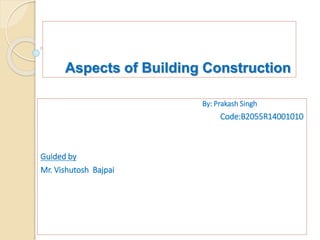
Building Construction Materials and Elements
- 1. Aspects of Building Construction By: Prakash Singh Code:B2055R14001010 Guided by Mr. Vishutosh Bajpai
- 2. Overview Why do we need buildings? Process of building construction Constraints on building construction Elements create building load Forces delivered to Earth for building to be structurally sound Basic Components of building Identification of Construction materials
- 3. Why do we need buildings? Safety- from natural hazards,animals,protection from things detrimental to human health Recreational Purpose- Cinema hall, Markets, Malls, Gaming Centre. Services-Hospitals ,Schools , Colleges. Day to day activities of human being food, sleep ,waste disposal We need services that provide energy,communications,water and disposal of wastes. We need less light by day and more light by night, than is offered by the natural world.
- 4. Cyclic Process of building construction The main stages are: 1. Planning 2. Design 3. Tendering 4. Construction Process 5. Handover 6. Evaluation
- 5. Constraints on building construction Health codes Fire codes Plumbing codes Electrical codes Building contractors and Labour Union Regulations
- 6. Elements create building load Various loads are taken into account while designing the foundation of a structure. Two broad categories: Dead loads Live loads Specific terms for dead loads and live loads: Concentrated load Distributed load Design load Undesigned load Fire load
- 7. Imposition of Loads Loads must be transmitted to structural elements. Terms associated with imposition- Axial load Eccentric load Torsion load
- 8. Forces delivered to Earth for building to be structurally sound Structural Elements Building is an assembly of structural elements designed to transfer loads to the earth. Can be defined simply as: Beams Columns Walls Connections
- 9. Beams Transfer loads perpendicular to its length. Types of beams Simple beam Continuous beam Cantilever beam Lintel Girder Joist Truss and purlin
- 10. Columns Any structural component that transmits a compressive force parallel through its centre. Typically support beams and other columns Generally vertical supports of building Can be vertical, horizontal or diagonal
- 11. Walls Really long, but slender column Two categories- -Load bearing walls It carries weight of beams, other walls,floors,roofs,other structural elements. IT carries weight of the wall itself. -Non-load bearing walls Need only support its own weight. Example are partition wall between two stores in a strip mall.
- 12. Connections Weak link as it relates to structural failure during fires - Often small, low-mass material that lacks capacity to absorb heat. Three Categories- Pinned Rigid Gravity
- 13. Basic components of building 1. SUPER-STRUCTURE 2. SUBSTRUCTURE- Plinth,D.P.C.,Walls and columns,Floors,Beams,Slabs
- 14. Identification of Construction materials Many factors determine which material is used to form structural elements- Cost Application Engineering capabilities Adaptability Each material react to fire in a different way.
- 15. wood Most common building material Relatively inexpensive Marginal resistance to forces compared to weight. Native wood with more mass takes longer to burn before strength is lost. Engineered wood Plywood delaminates when exposed to fire. Some composites fail through exposure to heat without burning.
- 16. Steel Mixture of carbon and iron ore. Excellent tensile,shear strength. Popular choice for- Girders Lintels Cantilevered beams Columns Losses strength as temperature increase.
- 17. Concrete Mixture of portland cement,sand,gravel and water. Excellent compressive strength. All concrete contains some moisture. Under heat,moisture expands and causes concrete to crack . Concrete can stay hot long after the fire is out.
- 18. Masonry Common term that refers to brick,concrete block and stone. Used to form load-bearing walls Veneer wall supports its own weight. Mortar holds units together and have little or no tensile or shear strength. Excellent fire resistive properties.
- 19. Cement Mixture of calcium silicates and aluminium silicates and aluminium ferrite. It gives good compressive strength. It has good setting time It is hygroscopic material We use as binding material.
- 20. THANK YOU